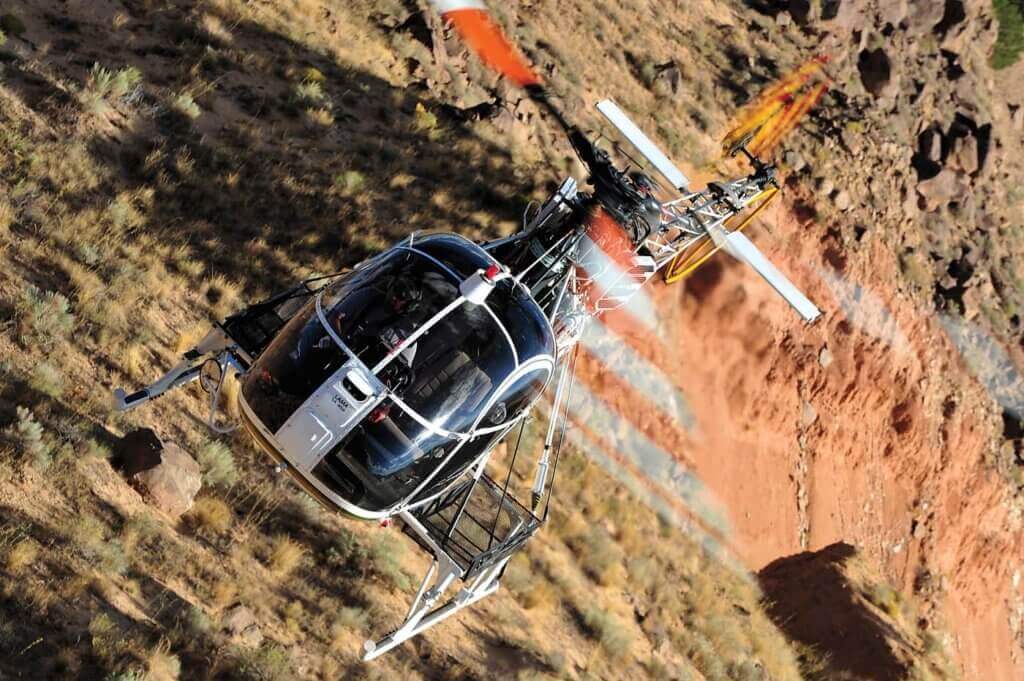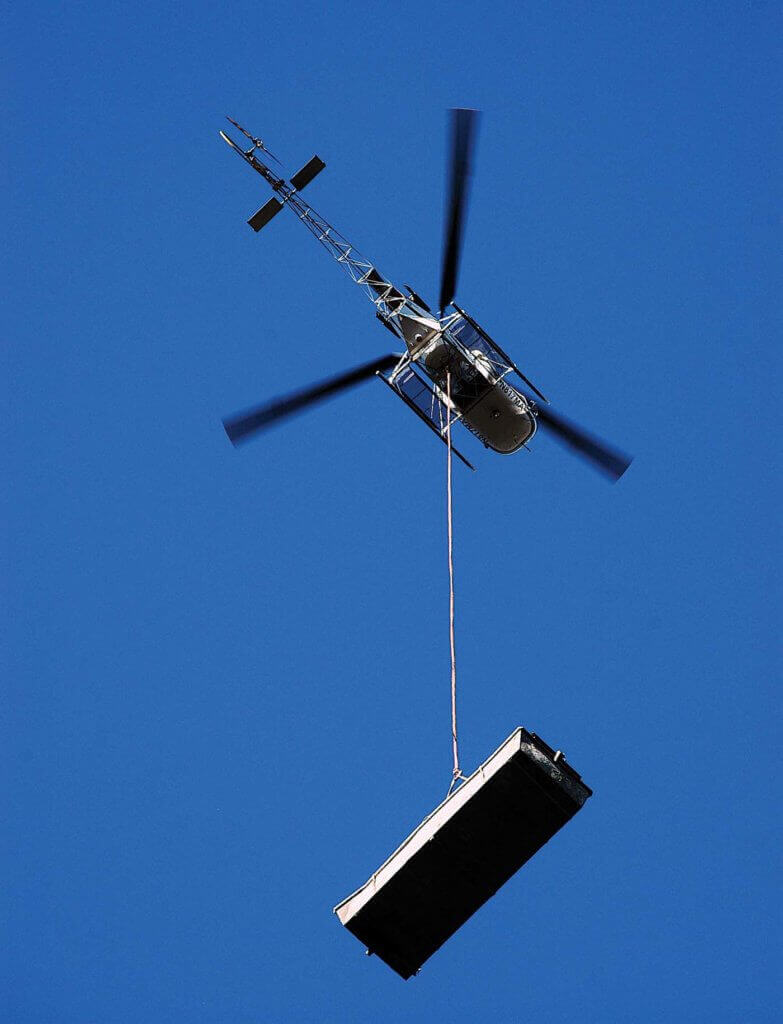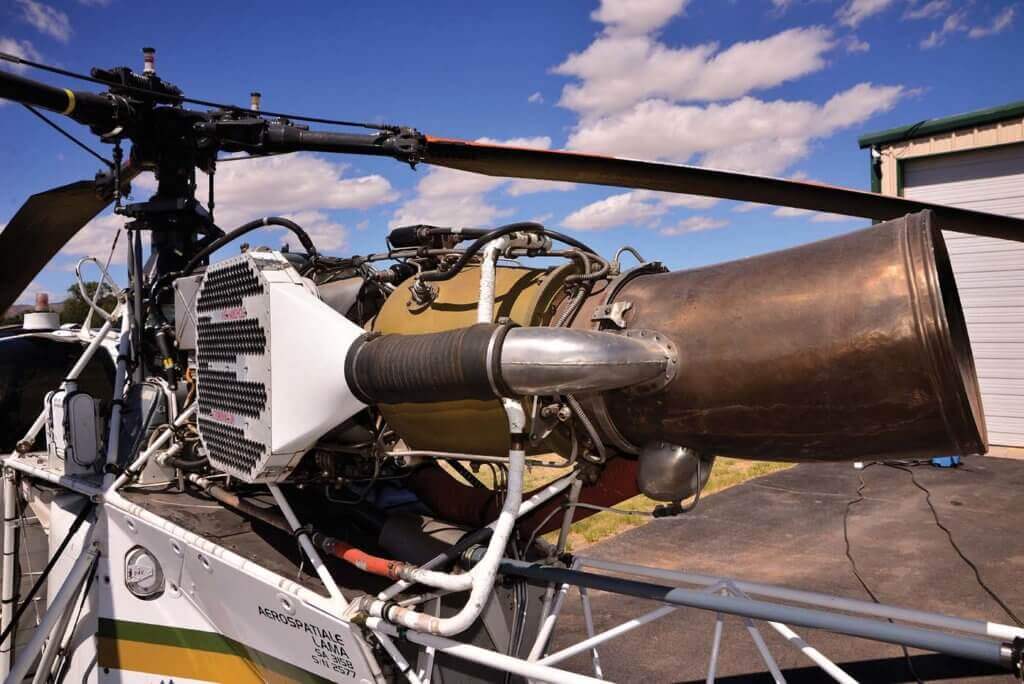The Aérospatiale SA 315B Lama is a rare sight in U.S. skies these days — so if the opportunity to photograph one on an air-to-air shoot arises, it’s hard to turn it down. In its day, the Lama’s altitude performance was unmatched, and it was famed for its reliability. But once the Airbus AS350 B3 and B3e (H125) AStar entered the market, matching and then exceeding the Lama’s hot and high performance, the older aircraft’s fate was sealed.

Dwight Jones, owner of Mountain Air Helicopters of Los Lunas, New Mexico, flew Lamas in his fleet for 17 years. But while the Lama was still certainly capable of the tasks it was assigned, Jones found his utility customers were increasingly asking for the Airbus H125 instead. Add to this the Lama’s high operating cost and the difficulty of obtaining parts in a timely manner, and Jones said it was clear its time as part of the Mountain Air fleet had come to an end. But before the company’s two Lamas were sold, Jones invited Vertical to join him on one of his last flights in the aircraft for a special photo shoot — the results of which you can see here.

Birth of the Lama
The Lama program started in the late 1960s, following a request from the Indian and Nepalese militaries for a helicopter that could operate in the extreme mountain ranges of both countries. The aircraft mated the lightweight five-seat SA 313 Aérospatiale Alloutte II airframe with the dynamic components of the larger and heavier seven-seat Aérospatiale SA 316 Allouette III. The goal was extreme hot and high performance, with the ability to lift a useful load well beyond 10,000 feet. Aerospatiale engineers hoped that by combining the best from these two aircraft, they would be able to accomplish this.

On March 17, 1969, the SA 315B Lama, powered by a Turbomecca Artouste IIIB turbine engine (de-rated to 550 shaft-horsepower), lifted off on its maiden flight. It achieved certification on Sept. 30, 1970, and entered service in July 1971. The Lama quickly became popular around the world for high altitude mountain operations, including for oil-and-gas exploration, long line equipment placement, lift work, firefighting, and search-and-rescue.

Due to its superb hot and high performance, the SA315B is particularly suited to working in mountainous areas, and it soon proved it could lift slung loads of up to 2,205 pounds (1,000 kilograms) to places a much more powerful medium helicopter could not venture. In the extreme mountain ranges of India and South America, the helicopter could lift heavy loads and rescue people in places that were not previously possible.
It secured its most notable high-altitude achievement on June 21, 1972, when Aérospatiale test pilot Jean Boulet took the aircraft to 40,820 feet (12,442 meters) — an absolute altitude record (for its class of helicopter) that still stands to this day. Soon after it reached its peak altitude, the engine flamed out — and Boulet brought the Lama to an unpowered landing, setting another record for the highest altitude autorotation.
Pilots loved the Lama because of its strong engine, stability in the hover, and — in the firefighting mission — the ability to lift a bucketful of water almost anywhere asked of it. For oil-and-gas support in the Colorado mountains, pilot Steve Ricks told Vertical: “We put a full load of fuel in it, four passengers, and their equipment — and even during the summer months we never ran out of power. Today, in comparison to an AStar, it is high maintenance, but . . . other than speed can do anything the AS350 B3e can do. The Lama was a high altitude powerhouse — we slung a lot of cargo with it and it was an amazing platform for scouting line and reconnaissance. You could remove the doors and have a great view.”

Since entering service, the Lama has flown almost every possible mission around the world. It has flown mountain rescues throughout Europe, Asia, South America, and North America; it has completed oil-and-gas exploration support in the U.S. mountain states, proving it can lift heavy loads on the warmest days; and it has performed firefighting work throughout the U.S. from the 1970s to the present day. (During fire operations the Lama was used as a command and control platform, for personnel transport, and as a direct fire attack aircraft using a Bambi Bucket.)
But after nearly 45 years of service, the Lama is slowly being retired — and it is being left to the H125 to continue the fine high-altitude tradition the Lama established, performing a vital array of missions in the most extreme conditions in the world.






I have many fond memory’s of hours flying the Lama, it was nicknamed the John Deer of helicopters and it lived up to its nickname. The AStar may lift as much as the Lama it will never replace the Lama
This is one of my favorite helicopters and I think it is an absolutely beautiful helicopter.
I spent many wonderful years flying the Lama in North America, South America and elsewhere. It was noisy, loud, and flung oil and grease everywhere, but I loved it. It always “spoke” to me before we had any problems and pulled me out of some very tight spots. Will hate to see it retired.
Steve – a lot of memories flying with you on the seismic trail in various craft – Lamas, 206s, etc. Hope you’re well.
One of the greatest Helicopter’s of all time. Still to my knowledge, it holds the absolute altitude record, 21 June 1972, Jean Boulet took off in a Lama and 40,800 ft later, engine flamed out, followed by the longest auto-rotation ever. I’ve seen the A-Star land on top of Mt Everest, ( Not bad ) but remember the Lama was over 10,000 ft higher in the sky than the A-Star on top of Everest ! ! Super loud but very dependable engine. I first flew in one with my Dad at age 9 in Tacoma, WA. We did a straight in auto over the Narrows bridge into KTIW. Amazing helicopter. Sad that she is leaving the skies soon.
Still the best toughest honest reliable helicopter in the world. Pity the french killed the lama with their arrogance and deliberate slow parts supply.
When the shiney arsed B3 arrived on the scene and they filmed it scortching around the mountains, guess what was following it doing the filming. Yep the lama.
Funny how the Indians have repowered their lamas with a 1050 horsepower engines and chose this helicopter over any other type to supply their troops in the mountains. The lama will live live for ever.
Excellent Article Skip. It will be sad to see the Lama being retired. A great machine.
The Lama, called Cheetah in the Indian Armed Forces, has done (and will continue to do for another decade) a task that no other helicopter can do. We, REGULARLY, day-in and day-out land at 19,300ft density altitude; each pilot does about four takeoffs and landings, with the first sortie carrying only 25 kg of load, which gradually increases to around 100 odd kgs.
We have now modified it with a more powerful Turbomeca 333B engine which makes engine governing easy at those altitudes and prevents engine surge. A pilot breathes easier as he comes up on collective to come to a hover at 19K feet!
The Lama is a class apart, a legend for us.
Having operated the Lama in Scotland since 1972 in a multitude of underslung operations, Algeria on Mag survey, Turkey on seismic ops, Yemen where we flew 6 Lamas over a 10 month period logging 7,000 hours with one days unscheduled unserviceability, Ethiopia, Kenya and South America it is with out a doubt the most wonderful, reliable and capable helicopters ever built and a great pity that it is due to be retired and will be missed by many operators.
Its all said and printed !! My heard is bleeding since my bum was glued a long time to the seats of Alouette-IIs, IIIs and Lamas !!
I was based at Australia’s Casey Station in Antarctica in 1986. I remember a Lama being used to sling five 200 litre drums at a time of ATK from the ship into the base during resupply – probably only a kilometre or so. We had to refuel it every few runs because the pilot was running only a quarter or so tank of fuel to save weight.
I was lucky to get a flight in it – one awesome machine! I might have some photos, buried somewhere in numerous boxes of Kodachrome slides …
i love Uwe Heins’s comment. my bum has been glued to the lama’s net patterned seat for a long time too as a recon pilot in the indian army. i have landed and taken off with her at 17273 ft amsl (18700ft DA on that day) in the northern himalayas and 10,000 to 12,000 feet amsl with 2 pilots and full fuel was no sweat. she will always be the love of my flying life. flying noe between the dunes at 10 ft at 95 knots in the indian desert with doors off was like a personal formula one experience.
The Lama was the absolute king of US seismic oil and gas exploration from the 70’s through the 90’s. We slung heavy loads of cable, electronic equipment and high-explosives through the peaks and canyons of the Rocky Mountains at altitudes of 14K with density altitudes far exceeding that. The Lama holds a special place in the hearts of thousands of US heliportable exploration employees and will never be replaced!
The Lama’s were epic! The king of the Rocky Mountain high country. I was in seismic exploration for over 40 years we used the Lama right up into 2018. Slowly Eurocopter stopped supporting parts and supply’s became tight. I have a “retired” lama tail rotor in my shop as a ceiling fan… it’s been turning 24/7 fir 3 years. Never had to grease the long shaft! Lol.